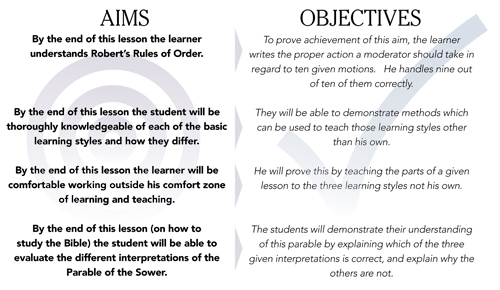
When you finish teaching your lesson or preaching your sermon, how do you know if you accomplished anything? You won’t unless you have set goals for yourself.
No matter what learning style you are trying to reach, you cannot just present facts. Instead, you need to know what your plans (goals) are. In Part 8 of this series, a lesson plan format was presented (available on line). On page one it asks you to think through two things: what is your AIM and what are your Objectives.
An aim is written in broad terms stating what the pupil should learn. It does not state what the learner will do to prove he has learned; it states in relatively broad terms the direction of learning. Aims do not state what the teacher will do to teach the lesson. They tell what happens or will happen to the learner by the end of the lesson.
Objectives are what the student does to “prove” the lesson aim has been achieved. How many times have you finished teaching a lesson and walked away not having a clue if what you just did accomplished anything? You feel like you have “taught” a great lesson, but do you really know if the student has walked away not only having heard a great lesson, but has something he can do with it? Instead, you can look back at your lesson plan and know for sure if you accomplished anything by reviewing your goal (aim-objectives).
Writing aims and objectives are not complicated, but they are necessary if you want to accomplish anything more than you talking for an hour. Here are a few examples. The aim is in bold (left), and the objective is in italics (right):

The writing of aims and objectives need not be seen as a daunting task. It is, however, the only way you can know if you have accomplished your goal for that lesson. To help you with this I will make available a complete study on the writing of aims and objectives. Just write me and request it at dbennett@pcanet.org.
Next time we go over how to write objectives for each of the three domains of objectives – what you want them to know, to be, and to do. e
– Dennis Bennett, Coordinator of Resources
